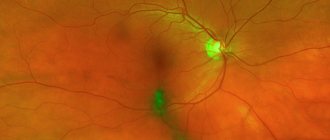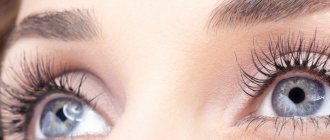Stinging, itching in the eyes and a feeling of “sand in the eyes” are a common complaint with which patients turn to an ophthalmologist. There can be many reasons for this condition, so self-diagnosis, much less treatment, is not worth it.
“Sand in the eyes” is a common, so to speak, everyday name for a symptom in which there is a sensation of a foreign body (or bodies) in the eye. In such a situation, it is necessary to visit an ophthalmologist for diagnosis and proper treatment.
What it is
This is not a separate disease. Sand in the eyes is one of the symptoms that occurs in many diseases, and its presence or absence will tell the doctor practically nothing. The most important reason for this condition is a violation of the quality of the protective tear film that covers the eye - it becomes too small and it becomes thinner, as a result of which the eye dries out. Then, in addition to “sand,” “pleasant” accompanying symptoms appear - pain, burning, profuse lacrimation, redness of the sclera.
Dry eye syndrome
The feeling of sand in the eyes is called “dry eye.” This is not entirely true - a similar symptom occurs in many ophthalmological diseases. Its short name is SSG.
To imagine such sensations, a healthy person needs to stop blinking for a minute - the eyes first dry out and begin to tingle, and then they quickly fill with moisture. The eyes become red and inflamed. There is often profuse lacrimation. With this condition, you often feel sand in your eyes in the morning, when it hurts to look even at dim light. Many people independently “diagnose” themselves and “prescribe”, again, independently selected eye drops.
Almost every patient talks to the ophthalmologist about the symptom of “sand in the eyes”. And in order to begin treatment correctly, you need to find out all the reasons why this feeling arose.
Causes
What should you do if you feel like there is something in your eye? The most important thing is to find out the cause in time and remove it. In most cases, the feeling of “sand” does not mean anything serious; something actually “got” into the eye.
Foreign body in the eye
On a windy day, or on a dusty road, this often happens - a foreign body actually gets into the eye. Most often, the feeling of sand in the eyes goes away quickly on its own - the lacrimal gland reflexively begins to produce more of its secretion and the eye cleanses itself.
But there are times when the trapped particle is too large and does not wash out on its own. It remains in the mucous membrane of the eye, causing redness and then inflammation. To prevent this from happening, you should, if possible, rinse your eye with plenty of clean water.
A large particle leaves a scratch on the mucous membrane. You could have already washed it out of your eye, but the painful sensations will remain for some time. To ensure your eye health, consult an ophthalmologist. Such microtrauma can provoke a serious illness.
It is much worse if a large object hits the eye and a penetrating injury occurs. It will not be possible to wash such an injury with a tear, and you cannot remove such an object yourself - you can introduce an infection into the wound and cause even greater inflammation. Only a doctor can help. For the very first relief, you need to use dark glasses, and cover the eye with a cloth on the side of the injured eye so that it is not irritated by the light.
Lacrimal gland dysfunction
The human eye must be constantly moisturized; for this, the lacrimal glands produce fluid. When blinking, the eyelids lubricate the eye with it. When this fluid is not enough, the eye quickly dries out. The tear fluid contains many other substances necessary for the eye - the nutrient medium that is created during blinking nourishes it, and a thin film of lubricant protects it from bacteria and external microorganisms. The lack of this fluid impedes the functions of the eye, leading to dryness and the sensation of a foreign body in the eye.
External factors
If a person spends a long time in a poorly lit room, the eye works under increased stress, and the gland does not have time to produce the required amount of fluid to lubricate and nourish the eye. As a result, the eye does not receive enough of everything it needs and begins to dry out.
The same painful sensations also occur when working in a place that is too brightly lit - the lens is not able to narrow so as not to injure the retina.
The same thing happens in a room with a running air conditioner - due to the constant movement of air, the eye dries out.
This symptom can occur in a room with a strong and pungent odor, in smoky rooms, and so on. The smell of freshly chopped onions can trigger this reaction.
Heavy loads
If they work for a long time in front of a monitor or with severe eye strain, they become overtired. The lens works worse, changes occur in the eye. More nutrition is required, which the lacrimal gland is not able to provide. There is a feeling of dryness in the eye, a feeling of a foreign body.
This feeling arises because a person, sitting in front of a screen, reflexively blinks less often, which means his eye is less moisturized. You need to train yourself to take breaks from work and blink more often.
This syndrome most often occurs in humans at the end of the working day, when the eyes are overtired.
In case of violations of the rest regime - if a person does not allow the eyes to relax, changes occur in them that require certain treatment.
Age-related and hormonal changes
With age, the composition of the tear fluid changes in any person; there is a lack of certain nutrients in it that are needed to lubricate the eye. To prevent the eye from drying out, the gland begins to secrete more and more secretion, this can lead to inflammation and a feeling as if there is sand in the eyes.
During the period of restructuring of the body, when hormonal levels sharply increase or decrease, dry eye syndrome can also be observed. This can be felt by teenagers going through puberty and people going through menopause.
In postmenopausal people, the flexibility and lability of blood vessels, including those in the eyes, changes. Blood circulation deteriorates in them, the eye does not have enough oxygen. This is also one of the factors for drying out the eyeball and, as a result, a feeling of sand in the eyes.
Dry eye syndrome can also occur in women during pregnancy and lactation. In this case, you just need to be patient and wait out the unpleasant sensations. And for relief, contact an ophthalmologist for preventive treatment.
For weather-sensitive people, upcoming weather changes can cause dry eyes.
Taking medications
Some medications cause vasoconstriction and reduce their conductivity. With others, the composition of the tear fluid changes, the eye is not able to receive all the necessary nutrients, and in some others an excess is detected. Because of this, the body tries to establish a balance, preventing excess substances from penetrating into the eye itself and disrupting its functions.
Dry eyes are caused by medications that lower blood pressure. Oral contraceptives have the same effect.
Inflammatory process
The development of an inflammatory process in the eye sometimes leads to the same result. It can be caused by conjunctivitis or other similar eye diseases.
Contact lenses can create inflammation if they are stored and used incorrectly - bacteria easily multiply on their surface in a warm and humid environment. The lenses themselves can also contribute to the gradual destruction of the tear film in the eyes.
Ophthalmologists call one of its causes an allergic reaction to any factors. One of them may be the use of low-quality cosmetics when applying makeup, especially in the eye area.
If you touch your eyes with dirty hands, they will also develop an inflammatory process.
This phenomenon is also caused by parasitic infestations.
Infectious diseases
Often the patient complains of sand in one eye, under the upper eyelid. This is caused by the fact that the infection covers not only the eyeball itself, but also the eyelids, muscles near the eye, glands, and can even affect the bone tissue of the orbit. The colony spreads throughout the eye, a large number of parasites accumulate under the upper eyelid and feel like sand. If you do not take immediate action, inflammation from one eye will spread to the other, and it will become more difficult to treat the pathology.
Sand in the eyes is felt with various infectious diseases, which at first glance are completely “innocent” - barley, cholazion, and other inflammations of the eyelids. Almost everyone has had them, sometimes they are practically asymptomatic and painless. The only visible symptom is a slightly swollen eye and a feeling of sand in it.
Causes and symptoms
Normally, the organ of vision is protected by the tear film, which is a tear fluid that covers the outside of the eye. A gritty feeling in the eyes may occur due to a lack of tear production or rapid drying.
Environment
Dust, wind, sun, polluted water are irritants for the organ of vision. The feeling of sand in the eyes sometimes occurs due to the operation of the air conditioner or heater. This occurs due to a decrease in air humidity, which contributes to dryness and redness of the mucous membrane.
Eye fatigue
With prolonged visual strain, a person blinks less often. Reduced blinking disrupts the distribution of protective fluid over the surface of the eye. Therefore, when reading for a long time, working at a computer, or driving a car, the visual organ may dry out.
Contact lenses
The feeling of sand in the eyes after removing lenses usually appears at the beginning of using optics. Contact lenses are a foreign object for the visual organ. They limit the supply of oxygen to the cornea, causing metabolic disorders. Therefore, adaptation is required; after getting used to it, the feeling of sand goes away.
Natural changes in the body
Age-related and hormonal changes lead to dysfunction of all organs. With age, the synthesis of tear fluid decreases. The restructuring of a woman’s hormonal system during menopause and during pregnancy causes the sensation of sand in the eyes.
Medicines
The appearance of symptoms is facilitated by antihypertensives, antihistamines, hormonal contraceptives, and cytostatics. After completing the course of therapy, the symptoms of dryness disappear.
Inflammatory eye diseases
Infectious and non-infectious diseases lead to symptoms of inflammation. Common diseases:
- Blepharitis is inflammation of the eyelids. With blepharitis, the edge of the eyelid becomes red and swollen, and a sticky discharge forms. There is a feeling of sand in the eyes, eyelashes sticking together in the morning.
- Conjunctivitis is an inflammation of the mucous membrane. Bacterial or viral conjunctivitis is manifested by redness, swelling of the conjunctiva, lacrimation, and pathological discharge. Allergic conjunctivitis occurs suddenly after contact with an allergen. With allergies, the eyes become very itchy and painful, red, and watery. A runny nose, skin rashes, and difficulty breathing may occur.
- Keratitis is inflammation of the cornea. There is redness of the mucous membrane, spasm of the eyelids, and blurred vision. A person experiences pain in the eyes, as if sand had hit them.
Mechanical damage
Minor injuries, burns, and foreign bodies in the mucous membrane lead to the development of symptoms of irritation. The eyes hurt, they water, the eyelids close. Mechanical impact damages the protective barrier and promotes infection.
Exophthalmos and lagophthalmos
The occurrence of exophthalmos (protrusion of the eyeball) occurs with hyperthyroidism, tumors or injuries of the orbit. Lagophthalmos (impaired closure of the eyelids) develops with injuries or damage to the facial nerve. Exophthalmos and lagophthalmos lead to rapid drying of the tear film.
Dry eye syndrome
With a lack of vitamin A, intense visual stress, drying of the tear film due to irritating environmental factors, Sjögren's syndrome develops dry eye syndrome. It is characterized by redness of the conjunctiva, rapid fatigue, and a feeling of sand in the eyes.
If for the first time you have a feeling as if there is sand in your eyes, it persists for a long time, does not go away, or other symptoms appear, then it is recommended to seek medical help.
Treatment
Only a doctor can perform treatment. At home, you can only alleviate your condition a little with the help of traditional medicine.
Make an appointment with an ophthalmologist, and based on your symptoms and the characteristics of your visual system, the doctor will be able to make the most accurate prescription. However, there are often situations in which it is not possible to visit a doctor for one reason or another, or the wait for an appointment is too long, in which case it is not recommended to endure discomfort in the eyes. What can be done in such a situation?
We recommend considering proven products with good reviews from consumers, without preservatives, that do not cause allergic reactions. When making your own choice, be careful and study the information about the drug in advance. Most often, for such symptoms as a feeling of sand, dryness and pain in the eyes, medications are prescribed:
Cationorm is a unique cationic emulsion for moisturizing the eyes, which restores all three layers of the tear film, permanently eliminating intense discomfort and the feeling of “sand” in the eyes that appear throughout the day, even in the morning, and prevents the further development of dry eye syndrome. Cationorm does not contain preservatives and can be used in conjunction with contact lenses.
Ocutiarz - eye drops with ultra-high molecular weight hyaluronic acid without preservatives to quickly eliminate discomfort, fatigue and foreign body sensation in the eyes, which appear at the end of the day after intense visual work. Ocutiarz is stored for 6 months after opening the bottle, it can be instilled onto contact lenses, and it is also often used to eliminate discomfort after ophthalmological operations on the cornea.
Oftagel is an eye gel with carbomer in maximum concentration that moisturizes for a long time, eliminates lacrimation, and does not require frequent instillation. It is used for such unpleasant symptoms as itching, redness, and a feeling of sand in the eyes. The advantage here is the fact that it can be used once at night, if it is not possible to instill moisturizing drops during the day.
Find the reason for this feeling
It could simply be too bright light, elevated body temperature, dry air, or any other factors. This is the simplest reason - you just need to try to remove the external irritant, and the “sand” will go away by itself.
If a similar feeling occurs after visiting the pool and contacting your eyes with chlorinated water, you should rinse your eyes from time to time during exercise. In this case, special swimming goggles help a lot - they cannot completely protect, but they greatly reduce the contact of mucous membranes with bleach. The same should be done when in contact with sea water.
In bright sunlight near water or snow, tinted glasses will help. They will also protect your eyes in strong winds.
Make lotions with herbs
Herbal cool lotions will fill your eyes with moisture and vitamins. Weak tinctures of string, calendula or chamomile are best suited. Hot lotions should not be used - if there is inflammation in the eye, high temperature will only help the infection to spread further. Using this method, you should not rub your eyes, for the same reason - there is a danger of spreading an infection. Therefore, you just need to put moistened wipes on your eyes and leave for a few minutes. This will also give your eyes the necessary rest.
After such lotions, you should make eye baths - dip your face in a cool infusion and just blink. The solution will moisturize the eyes and reduce pain.
Diagnostics
The cause of the discomfort is determined by an ophthalmologist. First, the specialist collects an anamnesis: clarifies the circumstances of the appearance and duration of the symptom, and identifies other complaints. The doctor evaluates the position of the eyes, the shape of the palpebral fissure, and the condition of the eyelids. In the presence of pain and blepharospasm, instillation of painkillers is performed before conducting additional studies. The following diagnostic techniques may be prescribed:
- Visometry.
It is carried out at the initial stage of the examination, with and without correction. If there is no object vision, light projection is studied. - Non-contact tonometry.
Allows you to detect ocular hypertension of various origins, hypotension in penetrating wounds. It is carried out on both sides. - Biomicroscopy of the eye.
The anterior segment of the eye is carefully examined by everting the upper eyelid. A fluorescein instillation test is then performed to detect minor defects. - Ophthalmoscopy.
With compensated intraocular pressure, it is performed against the background of cycloplegia. Makes it possible to assess the condition of the retina and the transparency of the optical media of the eye. - Ultrasound of the eye.
Prescribed for X-ray negative foreign bodies, the impossibility of a full visual examination using other methods due to corneal edema, hemophthalmos, and miosis. - Radiography.
Indicated for injuries. Allows you to detect radiopaque foreign objects and eliminate damage to the orbital walls. - Lab tests
. Informative for inflammatory and autoimmune processes, demodicosis, allergic reactions. Include microscopic examinations, microbiological analysis of smears, determination of antibodies. In case of allergies, special tests are additionally performed.
Forbidden
In order not to aggravate the situation, there are several categorical prohibitions if there is a feeling of sand in the eyes.
Rub your eyes
I especially want to do this when they are overtired. But in this way, the unpleasant sensations only intensify, and if there are foci of inflammation in the eye, then in this way they only spread over its entire surface. Instead of rubbing, just close your eyes for a minute. You can cover them with your palms to slightly increase the temperature and warm them up.
Try to remove a foreign body
This can further injure your eye. It’s better to force yourself not to blink this eye for a while, and the reflexively flowing tear will wash it away. Then it will be easy to remove the speck from the corner of the eye with a clean napkin.
Self-prescribe drops
If you are not an ophthalmologist, it will be difficult for you to determine the cause of such a symptom. Sometimes publicly available drops can greatly worsen vision and even lead to its loss.
If you have inflammatory diseases, you should not use any eye products without consulting an ophthalmologist. He will help identify the cause of the infection and prescribe the necessary treatment. If you prescribe a medicine yourself, you can find one that will only feed the infection.
Use contact lenses
Lenses themselves contribute to dry eyes - moisture does not get under them. Lenses do not always allow the required amount of oxygen to pass through, and if they are not stored correctly, they can cause irritation. Inflammation may even occur.
And if you also have dry eye syndrome, then contact lenses will only make it worse.
Prevention and prognosis of the disease
Even with a mild form of dry eye syndrome, high-quality and timely treatment is necessary. Constantly ignoring symptoms and refusing to visit a doctor can lead to complications, in particular partial or complete loss of vision.
To prevent the occurrence of the syndrome, it is necessary to undergo regular examinations by a doctor, drink the required amount of fluid per day, eat right, and if there is constant stress on the eyes, do preventive eye exercises.
If you don't pay attention to the sand in your eyes
If you let a problem take its course, it will not go away. What causes discomfort will only intensify.
- If a foreign body is stuck in the eye, then in addition to the fact that this phenomenon itself causes pain, inflammation forms at the site of the lesion. It can mature for quite a long time, and it will end with injury to the eyeball, chronic conjunctivitis, and in severe cases, even blindness.
- The same will happen if dry eye syndrome is left unattended - its constant inflammation will lead to chronic conjunctivitis.
- In other ophthalmological diseases, sand in the eyes will only increase inflammation and lead to a worsening of the underlying disease. With some of them, visual acuity may deteriorate and even be lost.
Symptoms of the disease
Dry eye syndrome has a wide variety of symptoms. All of them, as a rule, depend on the severity of the disease and manifest themselves differently for each patient. The main symptom is a feeling as if something has gotten into the eye (dust, sand). Then there is redness of the eye, pain and burning, increased lacrimation, sensitivity to bright light, and eye fatigue. Vision becomes blurry, and while using eye drops the patient feels severe, sharp pain.
All symptoms are more noticeable in the evening. Dry, dirty environments, cold, wind and long periods of working at a computer or with small parts can trigger the symptoms of dry eye syndrome.
If this disease is not treated on time, it can lead to irreversible consequences and even the need for surgical intervention.
Prevention
If you have already had such a problem and you have dealt with it, you need to be careful in the future and prevent it from happening again. You need to carefully monitor eye hygiene and follow simple rules.
- The most important thing is to touch your eyes only with clean hands.
- Before using cosmetics, you need to make sure that the tools, brushes, etc. are clean. All eye care accessories must be individual. You should not lend them to anyone or use someone else’s - this can cause infection in your eyes and cause inflammation.
- Take vitamins for your eyes - they will make them stronger and more resistant to viruses and bacteria, and your vision itself will be sharper.
- Use eye protection from ultraviolet radiation, especially where the sun is too bright - these can be high-quality dark glasses.
- Correct work at the computer - on average, you need to take short breaks every 30-40 minutes. Simply cover them and sit for a minute in a shaded place. If it is impossible to find such a place, you should use special glasses for working at a computer.
- The same applies to watching TV - you cannot watch it for a long time and immediately after working in front of the monitor. This mode will strain your eyes and make you feel like there is sand in your eyes.
- Carefully care for contact lenses.
Once again, sand in the eyes is not a separate disease, but only one of the symptoms of various conditions. If it occurs frequently, you should consult a doctor and undergo an eye examination so as not to miss the onset of a possible disease.
Sources used:
- Damage to the organ of vision in infectious diseases / Yu.Ya. Vengerov. - M.: Medicine, 2006.
- The power hidden in your eyes. Improving vision with the help of Integrated therapy / R.-M. Kaplan. - M.: IG “Ves”, 2010.
- Reasons for the development of myopia and its treatment / M.V. Kuznetsova. - M.: MEDpress-inform, 2005.
- Department of Ophthalmology - University of Colorado










